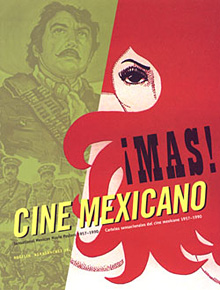 |
 |
 |
 Entertainment | June 2007 Entertainment | June 2007  
When Mexican Cinema Was Bad, Not Bad-Ass
 Oscar Villalon - SFGate.com Oscar Villalon - SFGate.com


| Mas! Cine Mexicano: Sensational Mexican Movie Posters 1957 - 1990 (Paperback)
by Rogelio, Jr. Agrasanchez
Check it out at Amazon.com |
God bless Alfonso Cuaron, Guillermo del Toro and Alejandro Gonzalez Inarritu. Thirty years ago, it would have been insane to think that Mexican filmmakers would be reveling in the sort of international peer recognition, not to mention box office success, that these three artists have received. (And we're not even counting the success of a Salma Hayek or a Gael Garcia Bernal.)

As I can attest to, having witnessed as a boy one cinematic atrocity after another on the craptastic screen of the Cinema Obrero in my dad's hometown of El Cercado, Nuevo Leon (que onda, primos?), Mexican cinema in the '70s and the '80s seemed to be based on a longstanding dare to purposely make movies worse than "The Cannonball Run." I mean, a lot worse.

But people still packed run-down small-town movie houses like the Obrero, hoping against hope, and no small reason for their attendance were the alluring and lurid movie cards and posters tacked up next to the box office. In "Mas! Cine Mexicano: Sensational Mexican Movie Posters 1957-1990" (Chronicle Books), Rogelio Agrasanchez Jr. amply presents examples of every sort of poster for every sort of genre that was out there, giving each type of movie a chapter of its own, with such descriptive headings as "Lawless Youth/Juventud sin ley," "The Macho Man/El macho," and "Women, Women, Women/Mujeres, mujeres, mujeres."

Agrasanchez provides an introduction (in Spanish and English) detailing the shift from Mexico's Golden Age of popular cinema, from the '30s to the '50s, to what could be called its Godawful Age, and politely notes the increasingly vulgar and exploitive work coming out of the studios of Mexico City. The posters in this collection hint at the rank cheesiness waiting to unspool before moviegoers slumped on broken wooden seats, but they also capture the latent artistry of the time. Some of the poster art is mysterious and provocative in ways the movies they promote don't even come close to fulfilling.

Aside from its nostalgic value, "Mas! Cine Mexicano" is a testament of sorts to the resilliency of Mexican culture. Just when it seemed Mexico was doomed to an endless string of Vicente Fernandez movies - a music icon whose "acting" proves that Pedro Infante and Jorge Negrete were so natural in front of the camera they made their jobs look easy - the celluloid snapped, the reel had to be changed, and the good stuff finally made it to the screen. | 
 | |
 |



